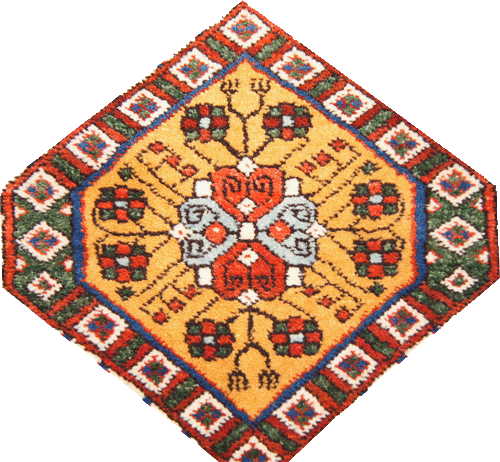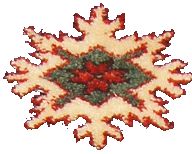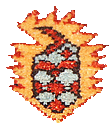
|
|
Shirvan Medallion Gubba
rug CODE: SHRGBB01 Size (metric): 88x177cm Size (ft): 2'11"x5'9" Area: 1.55 m2 Density: 180 000 knots per square meter, totally ~280 000 knots Weaving period: three months Colors (11): light blue (variegated), red (brick), salmon red, medium madder red, obergine, royal blue, variegated green, gold yellow, medium blue (Persian blue), natural ivory, natural brown. Dyes: 100% natural dyes: madder, weld (Reseda Luteola), indigo, pomegranate skins, walnut husks, natural brown sheep wool, natural ivory sheep wool Materials: Handcarded and handspun wool for pile, wool warps and cotton wefts Handwoven in Azerbaijan Design: The indigo field scattered with various polychrome floral, animal and geometric minor motifs around the central stepped medallion, in an ivory-green ground main border and outer dragon motif minor borders |
|
Contact us for more information about this rug

Apple Flower Motif
 Grape Leaf |
Mythological animal motif
|
|

Buta/Boteh has been used in Iran, Central Asia and Caucasus since the Sassanid Dynasty (AD 224 to AD 651). Some design scholars believe the Boteh is the convergence of a stylized floral spray and a cypress tree: a Zoroastrian symbol of life and eternity. A floral motif called Buteh, which originated in the Sassanid Dynasty (200–650 AD) of Iran and later in the Safavid Dynasty (from 1501 to 1736), was a major textile pattern in Iran and Caucasus during the Qajar Dynasty.
In these periods, the pattern was used to decorate royal regalia, crowns, and
court garments, as well as textiles used by the general population. According to
Azerbaijani historians, the design comes from ancient times of Zoroastrianism
and is an expression of the essence of that religion. It subsequently became a
decorative element widely used in Azerbaijani culture and architecture.
The pattern is still popular in Iran and South and Central Asian countries. It
is woven using gold or silver threads on silk or other high quality textiles for
gifts, for weddings and special occasions.
The usage of the pattern goes beyond clothing – paintings, jewelry, frescoes, curtains, tablecloths, quilts, carpets, garden landscaping, and pottery also sport the buta design in Azerbaijan, Iran and Central Asia.
Buta/Boteh is also one of the most important ornamental motifs of Mughal Indian art, consisting of a floral spray with stylized leaves and flowers. It is used in architecture and painting and in textiles, enamels, and almost all other decorative arts. The motif began to gain importance in the reign of the Mughal emperor Jahangir (1605–27). read more at www.azerbaijanrugs.com/arfp-shirvan-marasali-boteh-prayer-rug-111x153cm.htm
fertility symbol

|
For more information about the above rug or to place an order please email vd@azerbaijanrugs.com (Baku, Azerbaijan) or ra@azerbaijanrugs.com (San Francisco Bay Area). We will get back to you within 24 hours or less. |